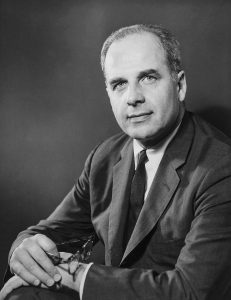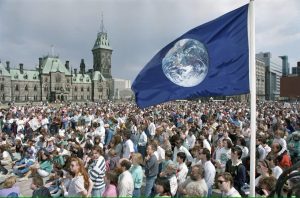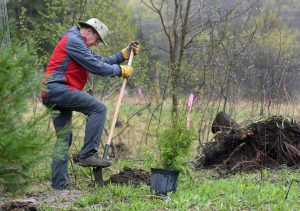History of Earth Day

Most people are familiar with Earth Day as a yearly occurrence on April 22 to celebrate the beauty of nature and get involved in protecting the environment. However, do you know the history of this important day? Keep reading to learn how Earth Day began!

1970s – The First Earth Day
The history of Earth Day begins long before the first Earth Day in 1970. Throughout the 20th century, the effects of the Industrial Revolution on the environment were beginning to come to light. Rapid industrial development in nations like Canada and the United States resulted in the degradation of the land, air, and water. However, for many decades the true impacts of this environmental destruction were unknown to the public. This began to change in the 1960s. In 1962, Silent Spring by Rachel Carson was published, which exposed the true cost of unchecked industrial agriculture on the environment. This was a watershed moment in environmental awareness, as the success of Rachel Carson’s book kicked off a growing movement of environmentalists who were deeply concerned about the importance of protecting the environment.

The two central figures of the first Earth day were Gaylord Nelson and Denis Hayes. Gaylord Nelson was a US senator from Wisconsin who saw both the importance of halted the continued deterioration of the environment and the potential of an international environmental movement. He also saw the potential of student activism as a powerful force for good, inspiring the idea of a teach-in on college campuses to promote action for the environment.
Denis Hayes was a young activist who Gaylord Nelson recruited for the movement. He helped to build the movement, going beyond university and college campuses and involving the public. Hayes put together a staff group to promote Earth Day events throughout the United States, growing the movement by leaps and bounds in anticipation of the first Earth Day. Together, they chose April 22 (a weekday between Spring Break and exam season) to maximize student turnout.
The first Earth Day had a turnout of 20 million Americans demanding a better future for the Earth. Earth Day brought together diverse interests from across political and occupational lines, joining them together for a common cause that contributed to the creation of the US Environmental Protection Agency, the National Environmental Education Act, the Occupational Health and Safety act, and the Clean Air Act.
In Canada, the first Earth Day saw a major protest in Windsor, Ontario that involved a mock funeral on the Detroit River, symbolizing the ecological death of the Lake Erie watershed. The 1970s also involved the Canada Water Act being passed and the creation of the Department of the Environment, marking major steps in the Canadian environmental movement.
1980s – The Movement Continues
After its first decade, Earth Day had already seen numerous successes. Throughout the 1970s further environmental legislation was enacted in the United States, including the Endangered Species Act, Marine Mammal Protection Act, Superfund, Toxic Substances Control Act, the Resource Conservation and Recovery Act, and the Clean Water Act. This decade also saw DDT and leaded gasoline banned, and the growth of the movement beyond the United States.

1990s – Earth Day Goes Global
In 1990, Denis Hayes was once again involved in organizing a major movement for Earth Day. Earth Day 1990 became a truly global movement, involving 200 million people across 141 countries calling for solutions to environmental issues. 1990 was also the first year Earth Day was officially celebrated in Canada, through the formation of the environmental charity Earth Day Canada. Earth Day 1990 focused on the role of communities and individuals in the environmental movement. Earth Day 1990 encouraged people to consider how their own decisions impacted their environment, and what they could do to create more environmentally-friendly communities.
2000s – Interconnected Climate
Earth Day 2000 was affected by two major global changes: climate and the internet. By Earth Day 2000 the issue of climate change was becoming more widely known, and activists around the world used Earth Day 2000 as an opportunity to sound the alarm about the growing threat of anthropogenic climate change. By 2000 the internet was also becoming more widespread, and was used as a platform to coordinate Earth Day action around the world.
2010s – Conversation & Education
Earth Day 2010 was an opportunity for further communication and collaborate on the environment. Activists engaged with civil leaders, began dialogues with elected officials, and engaged their communities to focus on sustainability and reducing carbon emissions. The 2010s also saw the signing of the Paris Agreement on Earth Day 2016.
2020s – The Work Continues
Due to the COVID-19 pandemic, environmentalists had to adapt for Earth Day 2020. This year saw online activities around the theme of “Climate Action”. These included Earth Day Live, a three-day youth-led livestream commemorating the 50th anniversary of Earth Day and encouraging continued action for the environment. Earth Day 2020 engaged over a billion people in caring for the environment, and the movement continues to grow.
References:
CBC/Radio Canada. (2022, April 22). The first-ever Earth Day and its evolution into a global event. CBCnews. https://www.cbc.ca/archives/the-first-ever-earth-day-and-its-evolution-into-a-global-event-1.5083110
EARTHDAY.ORG. (2024, January 23). The history of earth day. Earth Day. https://www.earthday.org/history/
Singla, I. (2021, January 21). The history of earth day. UCalgary News. https://www.ucalgary.ca/news/history-earth-day

Earth Day with Nature at McMaster
For Earth Day 2023, Nature at McMaster joined with the McMaster Centre for Climate Change, the Academic Sustainability Programs Office, and Trees for Hamilton in the second tree planting event at the McMaster Carbon Sink Forest, planting a total of 300 native tree species to create a model forest for future research (Click here to learn more about the McMaster Carbon Sink Forest Project!).
For Earth Day 2024, Nature at McMaster is hosting an Earth Day Series of three events: an interpretive hike at McMaster Forest, a ceremonial Earth Day tree planting behind Hamilton Hall on McMaster University Campus, and a Campus Ecological Stewardship event. Check out our events page to learn more about these and other upcoming events!
Nature Stories
